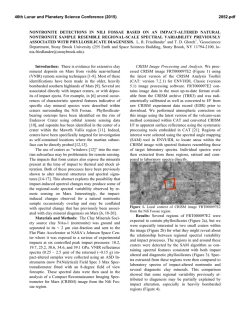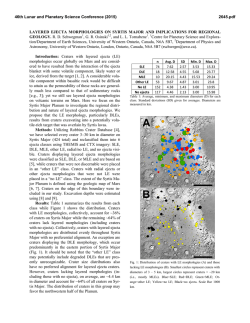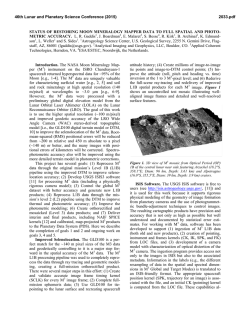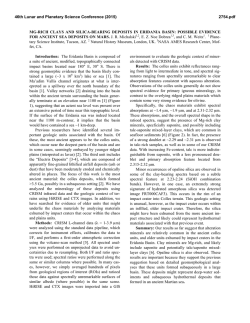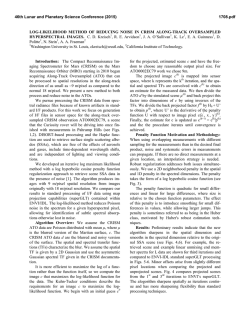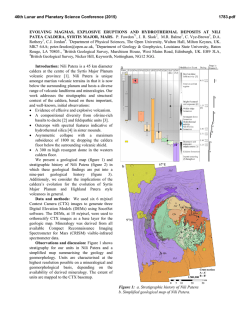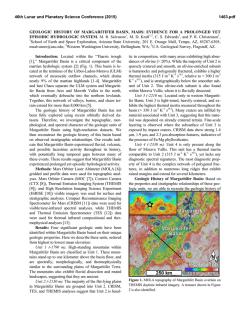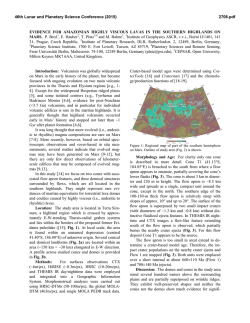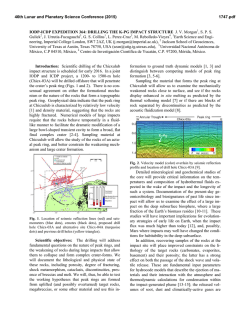
Abstract
46th Lunar and Planetary Science Conference (2015) 2090.pdf STRATIGRAPHY OF OLIVINE–CARBONATE–BEARING UNITS FORMING MESAS AND LINEAR FEATURES IN NORTHEAST SYRTIS MAJOR: IMPLICATIONS FOR EMPLACEMENT. M. S. Bramble1 and J. F. Mustard1, 1Dept. of Earth, Environmental, and Planetary Sciences, Brown University, Providence, RI, 02912 ([email protected]). Introduction: The Northeast Syrtis Major region of Mars features a diverse set of geologic units where the exposed stratigraphy has distinct units hosting phyllosilicates, carbonates, and sulfates [1,2], likely recording the chemical evolution of waters towards acidic pH [2], and hosts distinct ridge networks that possibly served as conduits for fluid flow [3]. In this contribution, we are investigating the detailed stratigraphy of a set of geologic units constrained within distances of several 10s of km to understand the spatial and temporal relationship of the mafic unit variably altered to carbonate [2,4]. The origin of this unit is controversial [1,5,6], but systematically studying it at the highest spatial resolution will help clarify its provenance. Methods: Morphological mapping of the study area (~17–18.5 °N and 76–78 °E) was performed using high-resolution imagery and Geographic Information Systems (GIS). Separate basemaps were made using data from the High Resolution Imaging Science Experiment (HiRISE) [7] and the Context Camera (CTX) [8]. Following [1,2], the spectral properties of the morpho-geologic units were characterized using the Compact Reconnaissance Imaging Spectrometer for Mars (CRISM) to identify the correlating mineral signatures [9]. The stratigraphic relationships between the units were assessed using Digital Elevation Models (DEM) produced with the NASA Ames Stereo Pipeline and HiRISE stereo pairs [10,11]. Geological Units of Interest: Within Northeast Syrtis Major is a key geologic unit that consists of three individual but related components that frequently form mesas (Figure 1), henceforth termed the Mesa Forming Unit (MFU). The uppermost unit displays a rough, corrugated, crater-preserving surface, topping a middle unit consisting of slopes shedding both light and dark-toned boulders variably exposing larger lighttoned blocks. The matrix of this middle layer appears darker in tone. Where the exposure is excellent some mesas display banding in this middle unit and/or a lack of boulder shedding. The lowermost component of the MFU is an extensive basal unit surrounding the mesa, and frequently extending at great distance beyond the vertical extent of the mesa. Light-toned blocks of various sizes are seen closely packed in this component amongst a darker matrix, and a sharp contact is seen with neighboring units, commonly smooth plains. Variable banding is observed in the lowermost unit. These mesas likely correlate with the olivine-carbonate units in the southwest similarly topped with a crater- preserving surface and prominent layering on the slopes [1,2,4,12]. Figure 1: (A) HiRISE subframe of ESP_015942_1980 showing Mesa Forming Unit (MFU) and A–A’ profile in (C). (B) Perspective view from the top right in (A) of MFU taken from a DEM made with the above image and ESP_016443_1980 5x vertical exaggeration. (C) Cross section of a MFU showing (a) the crater-preserving cap unit, (b) the boulder-shedding slopes, (c) the carbonate-bearing basal unit, and (d) the Fe/Mg phyllosilicate-bearing basement. Beneath this is a light-toned rough-surfaced unit with darker-toned gradual slopes extending out towards smooth plains. This Knobby Crustal Unit (KCU) is frequently observed as large coherent expressions or dispersed but coherent smaller knobs. 46th Lunar and Planetary Science Conference (2015) Two distinct linear features are observed throughout the study region. One category of linear features are 1– 5 m in height and width and several 100s of m long and are seen in varying states of exposure. These ridges are erosionally resistant, exposed in exhumed terrains, and have been characterized previously [3] to be breccia dykes formed during impact events [13] or fractures mineralized through sub-surface fluid flow [3]. These ridges are abundant in the southwest of the study area and decrease in abundance towards the northeast. Figure 2: Spectra from the (a) MFU cap unit, (b) LLF, (c) lowermost MFU component, and (d) KCU. Spectra in (a), (c), and (d) from image FRT00016A73, and (b) from FRT0001642E. Colors correlate with those in Figure 1C. We refer to the second category of linear features as Large Linear Features (LLF). They are 10s to 100s of m wide and 1000s of m long. Unlike the more common raised ridges the LLF are variable in height, sometimes exposed as raised ridges and sometimes as recessive troughs. Furthermore the LFF are commonly bounded by raised rims of a light toned material. Exhibiting a quasi-linearity, some are straight up to ~6 km, and some exhibit gradual or sharp bending. Where exposed the material comprising the LLF display is light-toned and blocky. A gradation in scale of the LLF is observed from sizes comparable to the linear ridge networks to those on the order of several km. The features appear stratigraphically related to lowermost layer of the MFU as they are seen to join with edges of this layer and grade into an extensive coherent basal unit. Preliminary Spectral Analysis: CRISM spectra of the units are shown in Figure 2. CRISM spectra collected of the MFU crater-preserving surfaces and ratioed to a spectrally bland region display a flat, unremarkable spectrum. The lowermost unit of the MFU and the extended LLF share a similar spectral signature displaying a broad 1 µm olivine absorption, and absorptions at 1.9, 2.3, and 2.5 µm. These spectra match the olivine-carbonate unit spectra identified elsewhere in Northeast Syrtis Major [2,4]. CRISM spectra collected of the KCU and ratioed to spectrally bland areas also display an unremarkable spectrum. 2090.pdf Relationships and Interpretations: The spectral features of olivine and carbonates in the LLF and the MFU are similar to the olivine-carbonate units to the southwest with magnesite alteration at base of the mafic unit [4]. These units are observed in topographic lows superimposed on basement rocks, and appear to be embedded units with the magnesite alteration observed at the edges of the rough, crater-preserving surface. In the northeast, the MFU and extended LLF mapped here are likely expressions of a related geologic unit, but one where the surrounding basement rocks have been eroded away leaving the LLF exposed on the smooth plains. The boulder-shedding slopes and craterpreserving surface have eroded back revealing the LLF over large areal extents, and generating dispersed mesas in regions of increased erosional resistance. This extends the observations of olivine-carbonate outcrops throughout Northeast Syrtis Major, from the units in the area of the Syrtis Major lava flows towards the southwest rim of Jezero Crater. The relationship between the mapped units allows inferences about the pre-existing topography. The resistant unit forming the LLF appears to fill fractures or depressions present in the basement at the time of emplacement. The MFU appears to embay the KCU, and LLF appear in present-day troughs between select larger coherent KCU. In other regions it appears on smooth plains, perhaps as the remnants of advanced erosion. The question remains as to the source of the MFU with its distinctive olivine-carbonate mineralogy. Two competing hypotheses describe the olivine-rich unit as the result of lava flowing into the region after the Isidis impact [6], or emplaced via the Isidis melt sheet [1,5]. The olivine-carbonate units, expressed as the LLF and lowermost component of the MFU, are observed to drape topography, appear in topographic lows, and exhibit quasi-circular morphologic structures. These observations appear to agree well with a more erosionresistant layer being emplaced by filling fractures, lows, and craters in an initial surface rather than fluid from a volcanic or mantle-tapping source filling to an equipotential surface. The LFF and MFU may prove valuable for providing a layer for relating the regional stratigraphy that appears to extend throughout Northeast Syrtis Major. References: [1] Mustard J. F. et al. (2009) JGR, 114, E00D12. [2] Ehlmann B. L. and Mustard J. F. (2012) GRL, 39, L11202. [3] Saper L. and Mustard J. F. (2013) GRL, 40, 245–249. [4] Mustard J. F. and Wiseman S. M. (2014) LPS XLV, Abstract #2583. [5] Mustard J. F. et al. (2007) JGR, 112, E08S03. [6] Tornabene L. L. et al. (2008) JGR, 113, E10001. [7] McEwen A. S. et al. (2007) JGR, 112, E05S02. [8] Malin M. et al. (2007) JGR, 112, E05S04. [9] Murchie S. et al. (2007) JGR, 112, E05S03. [10] Broxton M. J. and Edwards L. J. (2008) LPS XXXIX, Abstract #2419. [11] Moratto Z. M. et al. (2010) LPS XLI, Abstract #2364. [12] Ehlmann B. L. et al. (2008) Science, 322, 1828–1832. [13] Head J. W. and Mustard J. F. (2006) MAPS, 41, 1675–1690.
© Copyright 2026
